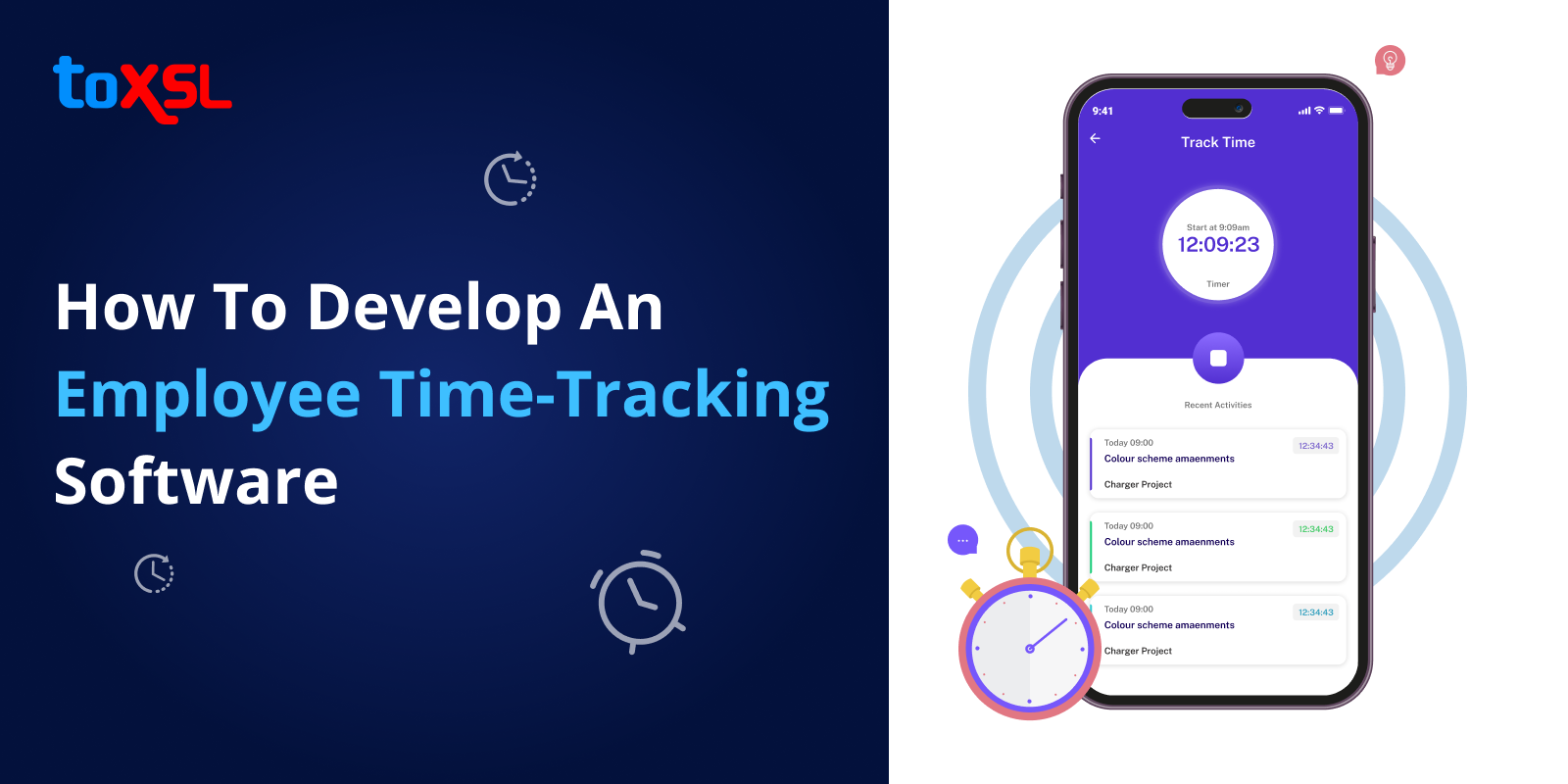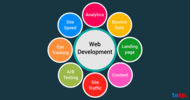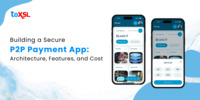- Oct 27, 2025
Share this post on:

According to verified market research, the time tracking software market is estimated to reach USD 12.3 billion by 2030, growing at a CAGR of 14.9%. Building time tracking software is a strategic way that can greatly enhance productivity and efficiency for businesses of all sizes.
As remote work becomes increasingly prevalent, the demand for effective time management solutions has surged. According to a recent survey, 70% of employees believe that time tracking tools improve their productivity, while 60% of managers report that such tools help them manage their teams more effectively.
How can building your time-tracking software enhance your team's productivity? What steps must businesses take to create a solution tailored to their needs? This blog serves as a comprehensive guide on how to build your own time tracking software, addressing common questions and providing insights into the development process.
Understanding the Need for Employee Time Tracking Software
Before diving into development, it’s crucial to understand why you need a time-tracking solution. Time tracking software helps individuals and teams monitor how they spend their time, which can lead to improved productivity, better project management, and accurate billing. Common uses include:
• Project Management: Tracking time spent on various tasks and projects.
• Billing: Ensuring accurate billing for clients based on hours worked.
• Productivity Analysis: Identifying areas where time can be saved or optimized.
Step-by-Step Guide to Building Employee Time Tracking Software
Creating your own time tracking software can be an exciting and rewarding project. Whether you're a freelancer, a small business owner, or part of a larger organization, having a tool to monitor how time is spent can significantly improve productivity and project management. This guide will take you through the step-by-step process of developing a time tracking application, from initial planning to deployment.
Step 1: Define Objectives and Features
Understanding Your Goals
The first step in developing attendance management software is to clearly define your objectives. Ask yourself:
• What problems will this time keeping software solve?
• Who is the target audience? (freelancers, teams, corporations)
• What specific features are necessary?
Key Features to Consider
Once you have a clear understanding of your goals, outline the features you want to include. Common features for time tracking software include:
• Timer Functionality: Start and stop timers for tasks.
• Manual Time Entry: Allow users to log hours manually.
• Project Management: Categories tasks and projects.
• Reporting and Analytics: Generate insights on how time is spent.
• User Management: For applications with multiple users.
This feature list will serve as a roadmap for your development process.
Step 2: Choose Your Technology Stack
Selecting the Right Tools
Choosing the right technology stack is crucial for the success of your project. Consider the following components:
• Programming languages: JavaScript (Node.js), Python, Ruby, or PHP are popular choices.
• Front end Frameworks: React or Angular can enhance the user experience.
• Database Options: PostgreSQL or MongoDB for data storage.
• Hosting Solutions: AWS, Azure, or Digital Ocean for deployment.
Your choices should align with your team's expertise and the specific requirements of your project
Step 3: Design the User Interface (UI)
Creating an intuitive UI
The user interface is critical as it directly impacts the user experience. Focus on simplicity and clarity:
• Dashboard: A central hub displaying active tasks and overall statistics.
• Time Entry Forms: Easy-to-use forms for logging hours.
• Task Management: Clear organization of tasks and projects.
• Reports Section: Accessible area for generating reports.
An intuitive UI allows users to navigate the software easily, minimizing confusion and maximizing efficiency.
Step 4: Implement Time Tracking Logic
Core Functionality Development
This step involves coding the core functionalities that will track and manage time. Key considerations include:
• Timer Mechanism: Develop algorithms for starting, stopping, and logging time accurately.
• Data Validation: Ensure entries are valid (e.g., no overlapping times).
• Flexibility: Allow users to categories their entries by project or task.
Accuracy in this phase is crucial; even minor errors can lead to significant issues in billing and project management.
Step 5: Develop project management features
Enhancing Functionality
Incorporating project management capabilities can add significant value. Consider adding:
• Task Assignment: Enable team members to be assigned specific tasks.
• Progress Tracking: Allow users to see how much time has been spent versus estimated time on tasks.
• Collaboration Tools: Facilitate communication among team members regarding task progress.
These features help users manage their workload more effectively while also tracking their time.
Step 6: Testing and Quality Assurance
Ensuring Reliability
Thorough testing is essential to ensure all features work as intended. Employ various testing strategies:
• Unit Testing: Test individual components for functionality.
• Integration Testing: Ensure different parts of the application work together seamlessly.
• User Acceptance Testing (UAT): Gather feedback from actual users to identify usability issues.
Quality assurance helps catch bugs early and ensures a smooth user experience upon launch.
Step 7: Deployment
Launching Your Software
After successful testing, it's time to deploy your software. Considerations during deployment include:
• Hosting Environment: Choose a reliable hosting provider that offers scalability options as your user base grows.
• Monitoring Tools: Implement tools to track performance and user engagement post-launch.
Having a plan in place for ongoing support and maintenance after deployment is essential for long-term success.
Step 8: Gather Feedback and Iterate
Continuous Improvement
Post-launch, gathering user feedback is crucial for ongoing improvement. Implement strategies such as:
• Surveys: Regularly survey users about their experiences with the software.
• Analytics Tools: Use analytics tools to track user interactions with your application.
Iterating based on feedback ensures that your software remains relevant and continues to meet user needs over time.
Benefits of Building Employee Time Tracking Software
1. Improved Resource Allocation
Time tracking software for employees provides managers with a clear view of how resources are being utilized. By analyzing data on employee work patterns, managers can allocate tasks more effectively, ensuring that workloads are balanced and no employee is overburdened. This leads to:
• Optimized Workflows: Tasks can be assigned based on availability and skill set.
• Reduced overhead costs: Efficient resource management minimizes unnecessary labour costs.
2. Enhanced Project Management
With accurate data on how long tasks take to complete, project managers can make better estimates for future projects. This leads to:
• Improved Scheduling: Projects are more likely to meet deadlines when timelines are based on historical data.
• Budget Management: Better estimates help in maintaining budgets by preventing cost overruns.
3. Increased Accountability
Employee time tracking app fosters a culture of accountability within teams. Employees know their time is being monitored, which can lead to:
• Higher Productivity Levels: Employees tend to work more efficiently when they are aware that their time is being tracked.
• Performance Evaluation: Managers can assess individual contributions more accurately, leading to fairer evaluations and promotions.
4. Elimination of manual processes
Manual timekeeping methods are prone to errors and inefficiencies. Time tracking software automates these processes, resulting in:
• Reduced administrative burden: Less time spent on paperwork allows employees to focus on core tasks.
• Minimized Errors: Automation reduces the likelihood of human error in time logging.
Benefits for Employees
1. Enhanced Productivity
Employees benefit from staff time tracking app as it helps them understand how they spend their time. This insight allows them to:
• Identify Time Sinks: Employees can pinpoint tasks using time tracker for employees that consume excessive time and adjust their workflows accordingly.
• Set Achievable Goals: With clear data on their performance, employees can set realistic targets for improvement.
2. Better Work-Life Balance
By accurately tracking hours worked, employees can avoid overworking themselves. Employee time keeping software enables:
• Flexible Scheduling: Employees can manage their hours more effectively, leading to reduced stress levels.
• Prevention of Burnout: Awareness of hours worked helps in maintaining a healthy work-life balance.
Benefits for Clients
1. Transparent Billing Practices
For service-oriented businesses, transparent billing is crucial for maintaining client trust. Time tracking software provides:
• Detailed Invoicing: Clients receive clear breakdowns of hours spent on their projects, enhancing transparency.
• Trust Building: When clients see exactly what they are paying for, it fosters long-term relationships.
2. Improved Client Communication
The ability to provide real-time updates on project status enhances communication with clients. This leads to:
• Timely Feedback: Clients can provide input based on up-to-date information.
• Increased Satisfaction: Clients appreciate being kept in the loop regarding project progress.
Strategic Advantages in Specific Industries
Construction Industry
In industries like construction, where project timelines and budgets are critical, time tracking software offers specific advantages:
• Accurate Project Tracking: Real-time updates allow for immediate adjustments when issues arise.
• Resource Management: Insights into worker attendance and performance help optimize labor costs.
Professional Services
For businesses that bill clients by the hour, such as consulting firms or agencies:
• Accurate Billing: Time tracking ensures clients are billed accurately based on actual hours worked.
• Project Profitability Analysis: Detailed reports help assess which projects are most profitable.
Cost of Developing Employee Time Tracking Software
The cost of developing time tracking software can vary significantly based on several factors, including the complexity of features, the development team’s location, and the specific requirements of the project. Here’s a detailed breakdown of the potential costs involved.
1. Initial Development Costs:
The average cost to start a time tracking app ranges from $50 to $130,000, with a median startup cost around $5,000. Basic functionalities like clock-in/out and time logs may cost between $20,000 to $50,000. More advanced features, such as automated invoicing and detailed analytics, can push costs upwards of $80,000 or more.
2. Annual Maintenance Costs:
Ongoing maintenance typically costs about 20-30% of the initial development cost each year. For example, if the initial development cost was $50,000, you should budget an additional $10,000 to $15,000 annually for updates and support.
Factors Influencing Cost
1. Project Scope and Feature Set: The complexity of your app directly impacts costs. Basic features are less expensive than those requiring advanced functionalities.
2. Team Composition and Location: The rates charged by developers can vary widely based on their location (e.g., North America vs. Eastern Europe) and their level of expertise.
3. Integration Needs: If your employee time management software needs to integrate with other systems (like payroll or project management tools), this can increase both initial development costs and ongoing maintenance expenses.
4. Deployment Model: The choice between a native app (iOS/Android), web application, or hybrid model will affect costs. Native apps generally require separate code bases for each platform.
Conclusion
Building custom employee time tracking app to track work hours can be a game-changer for organizations looking to enhance productivity and efficiency. By understanding your specific needs and following a structured development process, you can create a solution tailored perfectly to your team's requirements. As remote work continues to shape the future of business operations, investing in effective time management tools will be crucial for success.
So, if you are looking to hire the app development company, look no further than ToXSL Technologies. We have helped numerous businesses worldwide create innovative solutions as per their business needs. Contact us to learn more.
FAQs
1. What is employee time tracking software and why is it important?
Employee time tracking software helps businesses monitor work hours, attendance, and productivity. It’s important because it improves project management, reduces manual errors, and boosts efficiency by giving insights into how time is spent on tasks.
2. What features should be included in employee time tracking software?
Key features include clock-in/clock-out, timesheet management, project/task tracking, reporting tools, leave management, and integration with payroll systems. Advanced options may include GPS tracking and productivity analytics.
3. How much time does it take to develop employee time tracking software?
The development timeline depends on the features, design complexity, and technology stack. A basic version can take 4–6 weeks, while a custom solution with advanced features may take several months.











